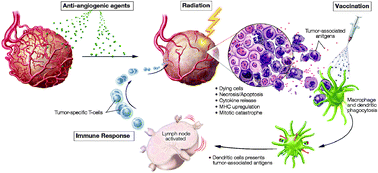Combining radiation, immunotherapy, and antiangiogenesis agents in the management of cancer: the Three Musketeers or just another quixotic combination?
Abstract
With the advent of new cancer therapies in the last few years, the goals of reducing disease burden and improving quality of life are frequently achieved. Yet despite the advances seen with numerous monotherapies, a multimodality approach that targets different aspects of tumor biology may yield the greatest clinical benefit for patients with late-stage disease. Many such strategies have been employed with varying degrees of success. The addition of immunotherapy to standard-of-care radiation therapy has shown evidence of efficacy in some preclinical models and in the clinical setting. However, exploiting these two modalities safely and effectively remains an ongoing challenge. It is feasible that the addition of another therapeutic modality could further enhance the antitumor effects of these treatments. The recent addition of


 Please wait while we load your content...
Please wait while we load your content...